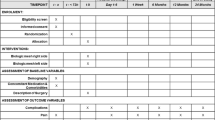Abstract
Purpose
We investigated whether new absorbable materials can be used in the treatment of inguinal hernia with the same efficacy as the traditionally used polypropylene.
Methods
We compared local tissue inflammation and fibrous reaction, postoperative complications (bleeding, wound haematoma, wound infection) and postoperative recovery time (time of mobilisation) in rats (Fischer strain) after implantation of a polypropylene mesh (PPM) (Prolene, Ethicon, Bracknell, UK) or a dual component fibrin mesh (DCFM) (Tachosil, Nycomed, Marlow, UK), between the muscle layer and the fascia transversalis defect. We further compared direct hernia repair methods using Lichtenstein’s operation in humans after implantation of either PPM or DCFM for fascia transversalis reinforcement regarding postoperative pain and complications, time needed for patient mobilisation, and recurrence.
Results
The results show that implantation of DCFM in rats resulted in milder inflammatory response and thicker fibrous tissue formation. Patients implanted with DCFM had significantly lower postoperative pain scores on a visual-analogue scale and lower analgesic use. The overall incidence of postoperative complications was significantly reduced with the use of DCFM. The incidence of recurrence after 24-month follow-up was the same in both groups.
Conclusion
This study has shown that DCFM has the same short-term efficacy in hernia treatment as the standard PPM, with a reduction in postoperative pain and analgesic use, and a decrease in overall postoperative complications. In the rat model, DCFM resulted in milder inflammatory response and thicker fibrous plate than the PPM. Further biomechanical testing and longer follow-up is necessary, but initial results are promising.
Similar content being viewed by others
References
Arslani N (2008) The effectiveness of tension free method and dual component fibrin mesh prosthesis in strengthening of transversalis fascia in rats and people. Dissertation, University of Zagreb
Read RC (1970) Attenuation of rectus sheath inguinal herniation. Am J Surg 120:610–614
Awad SS, Fagan SP (2004) Current approaches to inguinal hernia repair. Am J Surg 188(6A Suppl):9S–16S
Read RC (1995) The transversalis and peritoneal fasciae: a reevaluation. Lippincott, Philadelphia
Nordentoft T, Romer J, Sorensen M (2007) Sealing of gastrointestinal anastomoses with a fibrin glue-coated collagen patch: a safety study. J Invest Surg 20:363–369
Getman V, Devyatko E, Wolner E, Aharinejad S, Mueller MR (2006) Fleece bound sealing prevents pleural adhesions. Interact Cardiovasc Thorac Surg 5:243–246
Sagalowsky AI (2007) Editorial comment on: efficacy and safety of TachoSil as haemostatic treatment versus standard suturing in kidney tumour resection: a randomised prospective study. Eur Urol 52:1162–1163
Siemer S, Lahme S, Altziebler S, Machtens S, Strohmaier W, Wechsel HW, Goebell P, Schmeller N, Oberneder R, Stolzenburg JU, Becker H, Lüftenegger W, Tetens V, Van Poppel H (2007) Efficacy and safety of TachoSil as haemostatic treatment versus standard suturing in kidney tumour resection: a randomised prospective study. Eur Urol 52:1156–1163
Frena A, Martin F (2006) How to improve biliostasis in liver surgery. Chir Ital 58:793–795
Haas S (2006) The use of a surgical patch coated with human coagulation factors in surgical routine: a multicenter postauthorization surveillance. Clin Appl Thromb Hemost 12:445–450
Vaz M, Krebs RK, Trindade EN, Trindade MR (2009) Fibroplasia after polypropylene mesh implantation for abdominal wall hernia repair in rats. Acta Cir Bras 24:19–25
Amid P (1997) Classification of biomaterials and their related complications in abdominal wall hernia surgery. Hernia 1:15–21
Korenkov M, Sauerland S, Arndt M, Bograd L, Neugebauer EA, Troidl H (2002) Randomized clinical trial of suture repair, polypropylene mesh or autodermal hernioplasty for incisional hernia. Br J Surg 89:50–56
Klosterhalfen B, Klinge U, Hermanns B, Schumpelick V (2000) Pathology of traditional surgical nets for hernia repair after long-term implantation in humans. Chirurg 71:43–51
Shin D, Lipshultz LI, Goldstein M, Barmé GA, Fuchs EF, Nagler HM, McCallum SW, Niederberger CS, Schoor RA, Brugh VM III, Honig SC (2005) Herniorrhaphy with polypropylene mesh causing inguinal vasal obstruction: a preventable cause of obstructive azoospermia. Ann Surg 241:553–558
Peiper C, Junge K, Klinge U, Strehlau E, Ottinger A, Schumpelick V (2006) Is there a risk of infertility after inguinal mesh repair? Experimental studies in the pig and the rabbit. Hernia 10:7–12
Peiper C, Junge K, Klinge U, Strehlau E, Krones C, Ottinger A, Schumpelick V (2005) The influence of inguinal mesh repair on the spermatic cord: a pilot study in the rabbit. J Invest Surg 18:273–278
Badylak S, Kokini K, Tullius B, Simmons-Byrd A, Morff R (2002) Morphologic study of small intestinal submucosa as a body wall repair device. J Surg Res 103:190–202
Menon NG, Rodriguez ED, Byrnes CK, Girotto JA, Goldberg NH, Silverman RP (2003) Revascularization of human acellular dermis in full-thickness abdominal wall reconstruction in the rabbit model. Ann Plast Surg 50:523–527
Dejardin LM, Arnoczky SP, Clarke RB (1999) Use of small intestinal submucosal implants for regeneration of large fascial defects: an experimental study in dogs. Biomed Mater Res 46:203–211
Conflict of interest
The authors declare that they have no conflict of interest.
Author information
Authors and Affiliations
Corresponding author
Rights and permissions
About this article
Cite this article
Arslani, N., Patrlj, L., Kopljar, M. et al. Advantages of new materials in fascia transversalis reinforcement for inguinal hernia repair. Hernia 14, 617–621 (2010). https://doi.org/10.1007/s10029-010-0723-7
Received:
Accepted:
Published:
Issue Date:
DOI: https://doi.org/10.1007/s10029-010-0723-7




